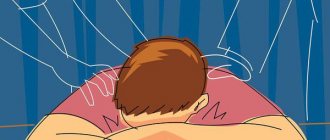Medical information is reliable Checked by Eremin Alexey Valentinovich
Hysterical personality disorder (hysterical psychopathy) is a disease that is manifested by demonstrative behavior and a person’s need for attention and positive assessments from others. The first symptoms appear in childhood and persist throughout life.
Psychotherapy is used to eliminate personality disorders. You can undergo treatment for mental disorders at Dr. Isaev’s Clinic. Traditional methods of psychocorrection and innovative developments in psychiatric practice are used here. The activities of the psychiatric department are licensed and approved by the Ministry of Health of the Russian Federation.
General information about the disease
Hysterical psychopathy is classified as a personality disorder. Characteristic manifestations are egocentrism, thirst for attention from others, demonstrative behavior and infantilism. Symptoms of the pathology are detected in 3-6% of the population of Russia and other countries. It occurs equally often in men and women.
People with hysterical personality disorder may not seek medical help. The pathology often does not affect their professional life, and they can achieve success in creative activities. However, in some patients, psychopathy progresses and leads to negative consequences: divorce, loss of property, loss of friends and loved ones.
Origins of the disease
The specific causes of the development of hysterical personality disorder have not been established. Psychiatrists believe that the occurrence of the disease is associated with three factors: genetic characteristics, the family upbringing system and organic brain damage in childhood.
Inherited character traits are different, but with hysterical psychopathy, transmission from parents of increased impressionability, emotionality and inability to notice small details is often detected. Damage to brain structures may be associated with pregnancy, childbirth, or early childhood.
In psychoanalysis, it is believed that a hysterical personality is often formed when parents transmit to their children attitudes that people initially have different power depending on their gender. status, social position. This occurs in a child’s childhood, including when adults refuse to accept his emerging sexuality. Not all psychiatrists agree with the opinion of psychoanalysts.
University
→ Home → University → University in the media → 13 psychotypes of personality: from paranoid to cycloid
They say there is a scale of psychotypes. How can you find out how your own child is growing up in order to help him fight his negative traits? Zinaida K., Gomel.
The classification of accentuations was developed by the German psychiatrist Karl Leonhard in 1968. Based on his works and the research of Russian psychiatrist Pyotr Gannushkin, Soviet psychiatrist, Honored Scientist Andrei Lichko created his own personality typology.
PARANOID
Traits of this psychotype rarely appear in childhood; the guys are focused on one thing, serious, preoccupied, striving to achieve what they want at any cost.
Dominant character trait: high degree of determination. Such teenagers subordinate their lives to achieving a goal (quite large-scale), while being able to neglect the interests of others. They are ready to sacrifice well-being, give up entertainment, comfort and other joys common to children.
Attractive character traits: high energy; independence; independence; reliability in cooperation when goals coincide with the aspirations of the people with whom they work.
Repulsive traits: irritability, anger, if something or someone gets in the way of the goal; weak sensitivity to other people's grief; authoritarianism.
The “weak link” of the psychotype: they are extremely ambitious in the grand scheme of things, not in small things.
Features of communication and friendship. When making contact, they often suppress their interlocutor, are overly categorical in their judgments, and can hurt others with their words. They don’t notice their own conflict. Completely unsentimental, friendship is viewed as a continuation of a common great cause. Friends are only comrades.
Attitude to study and work. Only those subjects that are needed now or will be needed in the future are carefully studied. To do this, they can go to the library, take extra classes, buy a lot of books, and read during breaks. And everything else in school is of no value. The greatest success is achieved in individual creative work. Unsurpassed generators of big ideas and non-standard approaches to solving complex problems. EPILEPTIOID From preschool age, children predisposed to this type are thrifty with clothes and toys. They react sharply to those who try to take possession of their property; From the first school years they show increased accuracy.
Dominant character traits: love of order, desire to maintain what has already been established, conservatism; high energy (students willingly engage in physical education, run, speak loudly, organize everyone around them, and with their activity often disturb others). In extreme situations, teenagers become brave and even reckless; in everyday life they show anger, explosiveness, and pickiness.
Attractive character traits: thoroughness, accuracy, diligence, frugality (often turning into pedantry), reliability (always keep promises), punctuality (in order not to be late, they will set 2 alarm clocks and also ask their parents to wake them up), attentiveness to health.
Repulsive character traits: insensitivity to the grief of others, excessive irritability due to noticed disorder, carelessness of others, or violation of rules.
The “weak link” of the psychotype: they cannot tolerate disobedience and violently rebel against infringement of their own interests.
Features of communication and friendship. They do not make casual acquaintances; they prefer to communicate with childhood friends and schoolmates. If they consider someone a friend, then they fulfill all the obligations that friendship imposes. Betrayal, either in friendship or in love, will never be forgiven.
Attitude to study and work. They are goal-oriented, complete all homework, do not skip classes, and are usually excellent students. Growing up, they perform best in work related to maintaining order, rules and regulations adopted by someone else (for example, a financier, lawyer, teacher, military man, etc.). HYPERTIME Those belonging to this psychotype have been distinguished since childhood by their noisiness, sociability, and courage; prone to mischief. They lack a sense of distance in relationships with adults.
Dominant character traits: high spirits, extroversion, joy from communication, good health and blooming appearance.
Attractive character traits: energy, optimism, generosity, desire to help people, initiative, talkativeness, cheerfulness; the mood is almost independent of what is happening around.
Repulsive character traits: superficiality, inability to concentrate on a specific task or thought, constant desire to do something more interesting at the moment, jumping from one thing to another (such guys sign up for several clubs or sections at once, but none for longer than 1– They haven’t walked for 2 months), disorganization, familiarity, frivolity, readiness to take unrestrained risks.
The “weak link” of the psychotype: cannot tolerate a monotonous environment, monotonous work that requires painstakingness or a sharp limitation of communication; they are oppressed by loneliness and forced idleness.
Features of communication and friendship. They always act as merry fellows and jokers. Their home is a meeting place for friends and acquaintances, where anyone can come and stay as long as they like. They are always drawn to the company and strive for leadership among their peers. They can easily find themselves in an unfavorable environment and are prone to adventures. They are not capable of deep affection. They are characterized by love for their neighbor (and not for all humanity); rush to help without hesitation. In friendship they are kind and unforgiving. Having offended someone, they quickly forget about it and will be sincerely happy the next time they meet; if necessary, they will apologize for the offense caused and do something nice.
Attitude to study and work. Schoolchildren of this psychotype would achieve significant success if they were not so frivolous and could concentrate on one subject. All subjects are easy for them, but the knowledge they receive at school is superficial and often unsystematic. They are constantly late for classes and skip classes (especially those classes in which they are bored and have no opportunity to express themselves). It’s easy to catch up on lost time: for example, before a test or exam, they don’t sleep for one night and learn almost everything.
Capable of achieving success in any business. At first, everything goes well for them, achievements appear, but if routine work begins, it becomes uninteresting, the activity ceases to be new, then they are ready to quit at the first opportunity and switch to something else.
Noisy and overactive, they often create the appearance of productive activity (they willingly and eagerly get down to business, plan a lot of events, hold meetings, etc.), which helps to advance their career.1
HYSTEROID
This psychotype is visible from early childhood. A cute baby, in front of a large number of adult strangers, recites poems, sings songs, and demonstrates his talents and outfits without any embarrassment. The main thing for him is admiring spectators. If guests sat down at the table and forgot about it, it will certainly attract attention again. If unsuccessful, he will knock over a glass on the tablecloth or break a saucer.
Dominant character traits: demonstrativeness; the desire to constantly be the center of attention, sometimes at any cost; thirst for constant admiration or surprise, veneration, worship.
Attractive character traits: perseverance, initiative, sociability, dedication, resourcefulness, activity, pronounced organizational skills, independence and willingness to take leadership (although after a burst of energy, the listed qualities quickly fizzle out).
Repulsive character traits: a tendency to intrigue and demagoguery, hypocrisy, cockiness, recklessness, thoughtless risks (but only in the presence of spectators), boasting about non-existent successes, taking into account only one’s own desires, inflated self-esteem, touchiness.
The “weak link” of the psychotype: inability to withstand blows to egocentrism, exposure of fictions.
Features of communication and friendship. They constantly need numerous viewers. In principle, this is the main form of their life (in public and for people). But, as a rule, they communicate only with those who express their admiration and idolize their abilities and talent. Very often they are selective, striving to be friends with famous people in order to be in the shadow of their fame, or with those who lose to them in order to shade themselves even more.
Attitude to study and work. Often this is just a reason for communication, an opportunity to express yourself among people. They go to school for fun. To attract attention, they study not just well, but better than anyone else, surprising teachers with their abilities in various subjects. In principle, these are gifted, talented people who are easily given professions related to artistic creativity. They work best outside the team and outside the mandatory framework. SCHIZOID Since school years, such children like to play alone, are not drawn to classmates, avoid noisy fun, preferring the company of older children. In adolescence, isolation and isolation, and an inability to empathize with others are striking.
Dominant character trait: introversion. This is a pronounced mental type, constantly analyzing the surrounding reality.
Attractive character traits: seriousness, restlessness, taciturnity, stability of interests and constancy of activities. As a rule, these are talented, smart and unpretentious schoolchildren. Productive, they can work on their ideas for a long time, but do not push through them, do not implement them.
Repulsive character traits: isolation, coldness, rationality. Such children have low energy and are inactive during intensive work - both physical and intellectual. Emotionally cold. Their egoism is unconscious. At the same time, they are vulnerable, because they are proud. They do not tolerate criticism of their system.
The “weak link” of the psychotype: they cannot tolerate situations in which it is necessary to establish informal emotional contacts, and the violent invasion of strangers into their inner world.
Features of communication and friendship. Very selective; people are hardly noticed, like many things in the material world. But they still need communication that is deep and meaningful. The circle of people with whom they come into contact is limited (as a rule, they are older). They are characterized by self-sufficiency in the sphere of relationships; they can communicate with themselves or with one person. A friend is one who understands their characteristics well and does not pay attention to oddities, isolation and other negative character traits.
Attitude to study and work. They are capable and talented, but require an individual approach, since they have a special vision of the world, their own point of view on ordinary phenomena and objects, unlike others. They know how to study a lot, but not systematically, because it is difficult to fulfill generally accepted requirements, and not according to the scheme they themselves invented. When they see that a teacher evaluates the result of work, and not formal compliance with mandatory rules, they show all their talent. If the teacher and parents require children of this psychotype to solve problems in a strictly defined way (as explained in class), then they will fall behind, despite the fact that they are quite capable of solving the same problems in several original ways. This applies not only to mathematics, but also to other academic subjects. Most often, such guys make excellent scientists, for example mathematicians or theoretical physicists. PSYCHASTENOID Along with some timidity and timidity, such children have a tendency to reason and have intellectual interests that are beyond their age. From a young age they suffer from various phobias - fear of strangers, new objects, darkness, being alone at home, etc.
Dominant character traits: uncertainty and anxious suspiciousness, fear for one’s future and loved ones.
Attractive character traits: accuracy, seriousness, conscientiousness, prudence, self-criticism, even mood, loyalty to promises, reliability.
Repulsive character traits: indecisiveness, a certain formalism, a tendency to long discussions, self-examination. There may be fears regarding an unlikely future, based on the principle “no matter what happens” (hence the belief in omens). Another form of protection against constant fears is conscious formalism and pedantry, which are based on the idea that if everything is carefully thought out in advance, foreseen and then acted without deviating a single step from the planned plan, then troubles can be avoided. Such teenagers find it difficult to make decisions; they constantly doubt: have they taken everything into account? But if they dare, they begin to act immediately, because they are afraid that they will change their mind.
The “weak link” of the psychotype: fear of responsibility.
Features of communication and friendship. They are shy, self-conscious, and do not like to make new contacts. They have few friends, but this friendship lasts forever. They remember the smallest details of the relationship and are sincerely grateful for your attention.
Attitude to study and work. They are able to study without raising their heads, showing determination, perseverance and perseverance for a long time, because they are afraid of upsetting their loved ones and teachers with low grades. The result obtained is checked against reference books, dictionaries, and encyclopedias; They'll call a friend and ask him.
These are ideal subordinates: they will complete any work carefully, accurately and on time, if the task is specific and there are instructions clearly regulating the procedure for its implementation. Such people like a quiet profession, for example, a librarian, accountant, or laboratory assistant. SENSITIVE From the first steps, these guys are fearful, afraid of loneliness, darkness, animals, especially dogs. They avoid active and noisy peers, but are sociable with those they are accustomed to; They love to play with kids: they feel confident and calm. They are very attached to their family and friends, these are “home children”: they try not to leave their native walls, they do not like to visit, much less travel somewhere far away (for example, to another city, even if their beloved grandmother lives there).
Dominant character traits: increased sensitivity, impressionability. Children are timid and shy, especially among strangers and in unusual surroundings. They see many shortcomings in themselves.
Attractive character traits: kindness, calmness, attentiveness to people, a sense of duty, high internal discipline, responsibility, conscientiousness, self-criticism, increased demands on oneself. They strive to overcome their weaknesses.
Repulsive character traits: suspiciousness, fearfulness, isolation, a tendency to self-flagellation and self-humiliation, confusion in difficult situations, increased sensitivity and conflict on this basis.
The “weak link” of the psychotype: they cannot tolerate ridicule or suspicion from others of unseemly actions or unkind attitudes.
Features of communication and friendship. They contact with a narrow circle of people who arouse their sympathy. They avoid meeting and communicating with the lively and restless in every possible way. They prefer to share experiences and sensations with old friends.
Attitude to study and work. They study because they do not want to upset their relatives and teachers. They are embarrassed to answer at the board, they are afraid that they will be called an upstart. With a friendly attitude from teachers, they show excellent results. For them, work is something secondary; the main thing is warm and kind relationships with colleagues and the support of their manager. They can be executive and devoted secretaries, assistants, etc. HYPOTHYMOUS They do not show much joy, they are offended by everyone, especially by their parents. There is an expression of dissatisfaction on their faces, frustration because they did not do it the way they wanted.
Dominant character trait: always in a minor key.
Attractive character traits: conscientiousness, keen critical view of the world. They strive to be at home more often, to create comfort and warmth, thereby avoiding unnecessary worries.
Repulsive character traits: touchiness, vulnerability, despondency, tendency to look for illness in oneself, almost no interests and hobbies. Fast fatiguability.
The “weak link” of the psychotype: open disagreement with a different perception of reality.
Features of communication and friendship. Often and for a long time they are offended by others and friends, although they urgently need communication, so that they have someone to complain about life, about the fact that they were not understood or appreciated. I like to talk about the difficult circumstances in which I found myself. The advice of your interlocutor will be answered with a lot of arguments why nothing can be changed and it will only get worse.
It is difficult to be friends with such children: they see in any person a possible reason for the deterioration of their mood.
Attitude to study and work. They prove themselves by memorizing the material well and carefully completing assignments, but they are not particularly interested in the depth and content itself. They study for fear of a bad grade. Citing illness, they may skip classes, most often in physical education, labor training and other subjects, the teachers of which do not make allowances for a bad mood.
It happens that they complain about people, circumstances, and ask to be given another task. But everything repeats itself: shortcomings, negative aspects in the organization of production or traits in others - a whole uprising in the soul. It's hard to do one thing all the time.
CONFORMAL TYPE
This type is quite common. Children agree with everything that their immediate environment suggests, but as soon as they come under the influence of another group, they change their attitude towards the same things to the opposite. They lose their personal attitude towards the world - judgments and assessments will coincide with the opinions of those with whom they communicate at the moment. Moreover, they do not stand out, do not impose their opinions, representing the masses who agree with the leader.
Dominant character traits: excessive adaptability to the environment, almost complete dependence on family and company. Life flows under the motto: “Think like everyone else, do like everyone else, and so that everything is like everyone else.” This extends to clothing style, behavior, and views on important issues. These teenagers become attached to their peer group and unconditionally accept its value system without criticism.
Attractive character traits: friendliness, diligence, discipline, flexibility. They will not be a source of conflict or discord. They listen to the guys’ stories about “exploits”, agree with proposals from leaders, willingly participate in “adventures”, but then they can repent. They lack their own courage and determination. If the micro-team seems significant and has a positive orientation, then together with it they can achieve serious success, for example, by studying in some section.
Repulsive character traits: lack of independence, almost complete lack of criticism towards oneself and the immediate environment.
The “weak link” of the psychotype: they cannot tolerate drastic changes or breaking the life stereotype.
Features of communication and friendship. They easily establish contacts with people and at the same time imitate leaders. Friendly relationships are fickle and depend on the current situation. They do not strive to excel among friends and do not show interest in making new acquaintances.
Attitude to study and work. If everyone around them studies well, then they will make an effort to keep up with their friends. The attitude towards work also depends on the mood of the team; are able to demonstrate diligence, diligence, creativity and ingenuity, and carry out everything that is assigned. Or they may shirk or do work formally if there are slackers nearby.
UNSTABLE TYPE Since childhood, they are disobedient, restless, climb everywhere, but at the same time they are afraid of punishment and easily obey their peers.
Dominant character traits: complete inconstancy of manifestations, dependence on any person who is nearby at that moment. Easily influenced.
Attractive character traits: sociability, openness, helpfulness, goodwill, speed of switching in business and communication. Often, outwardly, such teenagers are obedient, ready to fulfill the requests of adults, but their desires quickly disappear; very soon they forget about their word or are lazy, they come up with a lot of reasons why they cannot do what they promised.
Repulsive character traits: craving for empty pastime and entertainment, talkativeness, agreement, irresponsibility.
The “weak link” of the psychotype: neglect, lack of control.
Features of communication and friendship. Non-conflicting. Their contacts are pointless. They can be part of several groups at once, adopting the rules and style of behavior of each team. Tend to live for today; They sit for hours in front of the TV, listening to music. They act as assistants to leaders.
Attitude to study and work. Under the influence of another hobby, they may begin to study well or abandon their studies, which will inevitably lead to large gaps in knowledge. Further studies become more difficult. Their knowledge is unsystematic, their attention is unstable, and during lessons they are often distracted from work for a long time. Homework is done reluctantly. Such people do not make good specialists. ASTHENIC Since childhood, poor sleep, poor appetite, often capricious, afraid of everything. Sensitive to loud sounds, bright light; they quickly tire of even a small number of people; strive for solitude.
Dominant character traits: increased fatigue, irritability.
Attractive character traits: neatness, discipline, modesty, complaisance, diligence, friendliness, forgivingness.
Repulsive character traits: capriciousness, self-doubt, lethargy, forgetfulness. Such teenagers are timid, shy, have low self-esteem, and cannot stand up for themselves. They experience great anxiety when external circumstances change and stereotypes are broken, because their psychological defense mechanism is getting used to things and their way of life.
The “weak link” of the psychotype: sudden affective outbursts due to severe fatigue and irritability.
Features of communication and friendship. They do not strive for close relationships due to uncertainty and do not show initiative. The circle of friends is limited.
Attitude to study and work. Low self-esteem often gets in the way. Constant doubts, feelings of anxiety and fear of making a mistake prevent you from working normally in class or answering at the board, even when the material has been learned. Work is tiring and does not bring joy or relief. Heavy and tense causes irritation. They need periodic rest or alternation of different types of activities.
LABILE TYPE They often catch colds. They are capable of getting upset because of an unflattering word, an unfriendly look, or a broken toy. Pleasant words, a new suit or book, good news quickly lift your spirits and give a cheerful tone to the conversation, but at any moment another “trouble” can change everything.
Dominant character trait: extreme mood swings from insignificant reasons. The state of mind determines everything: appetite, sleep, general well-being, desire to communicate, learn, performance.
Attractive character traits: good nature, sensitivity, affection, sincerity, responsiveness (during periods of high spirits). Loyalty to those with whom you are on good terms, who are loved and cared for. Moreover, this attachment remains, even if the mood has changed.
Repulsive character traits: irritability, short temper, pugnacity, weakened self-control. During a normal conversation, they can flare up and say something impudent and offensive.
The “weak link” of the psychotype: emotional rejection of significant people, loss of loved ones or separation from those to whom they are attached.
Features of communication and friendship. It all depends on my mood. If you are happy and satisfied with life, then you establish contacts with great desire; if you are upset and not satisfied, then they are minimal. They have developed intuition and easily determine a “good” and a “bad” person when choosing a friend. They prefer to be friends with those who, during periods of low mood, know how to distract, console, tell something interesting, protect in the face of attacks from others, and, in moments of emotional upsurge, share wild joy and fun. Capable of loyal friendship.
Attitude to study and work. Characterized by extreme variability; They react unpredictably to remarks and requests from the teacher or parents: in response to a remark they are able to laugh and joyfully begin to correct the mistake, but tears, irritation, and reluctance to obey the legitimate demands of the teacher are quite possible. Knowledge is superficial and unsystematic, because such teenagers do not manage themselves and cannot be controlled by adults. They switch gears, forget about their bad mood, if the work interests them, doesn’t get boring, and captivates them. CYCLOID These schoolchildren are no different from their peers, but from time to time they are unusually noisy, mischievous, and are constantly doing something. Then they become calm and controlled again. Adolescents experience periodic phases of mood swings, the duration of which ranges from several days to a week or more.
Dominant character trait: cyclical changes in the emotional background (high mood disappears, emotional decline puzzles everyone).
Attractive character traits: initiative, cheerfulness, sociability, when your soul is good.
Repulsive character traits: inconsistency, imbalance, indifference, outbursts of irritability, excessive touchiness and pickiness towards others. If you are overcome by sadness, then everything falls out of your hands; What was easy yesterday requires incredible effort today. During a recession, it is more difficult to live, study, and communicate. Companies are annoying, risk, adventure, entertainment are losing their appeal. They become “homebodies” for a while.
Mistakes and minor troubles are very difficult to experience on pessimistic days. Just yesterday they won the tournament, but today the game isn’t going well, the coach is unhappy... It’s depressing, they don’t recognize their body, they don’t understand their irritation, they don’t want to see their loved ones. They respond to remarks and remarks with dissatisfaction, although deep down they are very worried about these sudden changes. There is no feeling of hopelessness; they are confident that after some time everything will be fine again. You just need to survive the recession period.
The “weak link” of the psychotype: emotional rejection by significant people, a radical break in life stereotypes.
Features of communication and friendship. Relationships with people are cyclical: the craving for communication, new acquaintances, reckless prowess are replaced by isolation, reluctance to talk even with parents and close friends (“I’m so tired of you all”). They are truly friends with those who understand this inevitability of change in relationships and are not offended and forgive outbursts of irritability and resentment.
Attitude to study and work. Periods of active work in the classroom and at home are followed by stages when complete indifference to anything sets in. In work, everything works out and works out as long as it’s interesting; as soon as the mood drops, they are dissatisfied with everything that is offered to them.
Based on the degree of severity, we can distinguish 2 types of character accentuations, which is necessary to know for an individual approach in raising a child, when choosing career guidance, forms of personal and family psychotherapy: • obvious accentuation - an extreme variant of the norm. Character traits are expressed throughout life; • hidden accentuation is a common variant of the norm. Some special character traits appear mainly during psychotrauma.+
These 2 types can transform into each other, which is influenced by family upbringing, social environment, professional activity, and physical health. In contrast to “pure” types, mixed forms of character accentuation are much more common. Natalya Grigorieva, Associate Professor of the Department of Psychiatry and Medical Psychology of BSMU, Candidate of Medical Sciences. Sciences Medical Bulletin , July 31, 2014
Share
Clinical manifestations of histrionic personality disorder
Symptoms of hysterical psychopathy appear in childhood or adolescence. The main clinical manifestations include:
- The appearance of psychological or physical discomfort in the absence of attention from people around.
- Emotional manifestations are superficial.
- Emotional lability is combined with frequent mood swings.
- Extravagant and provocative appearance. Patients strive to attract the attention of other people.
- Speech and gestures are pretentious, expressive, and different from the signs of normal reactions.
- Patients try to provoke people to pay attention and talk about themselves. Provocations are of a different nature, including often having sexual overtones.
- Events of the past are viewed through the prism of drama.
- Hyperactivity and enthusiasm, which quickly pass and are replaced by apathy.
- The sense of responsibility is reduced, and sometimes completely absent.
- Patients with hysterical personality disorder are easily suggestible; it is easy for them to put some thought into their heads in order to use them for their own purposes.
- Relationships with people and the degree of one’s own importance are assessed inadequately.
In psychiatry, it is believed that to make a diagnosis, it is sufficient for a person to have three or more of the above symptoms. It is important to understand that clinical manifestations of hysterical psychopathy do not always lead to antisocial behavior. The patient's desire to please people and receive their attention can be manifested by sociability, a desire to help, and general charm. Patients love to speak publicly and can interest others with their stories.
As psychopathy progresses, egocentrism and psychological infantilism intensify. The patient exhibits immaturity of judgment, perversion of behavior and emotional reactions, as well as lack of initiative.
Behavior of hysterics
As a rule, hysterics are inspired, capable of leading and captivating. However, this interest can quickly give way to another.
The hysterical monologue is endless, the interlocutor is drowning in word constructions that do not add up to a logically coherent text. “Well, don’t you understand, this is how it feels?”
They can talk about the same event that happened to them for hours. In terms of content, this text, if we convey only the essence, could fit in a few minutes.
Expressive. The hysteroid gesticulates a lot, and there are constant changes in intonation during the dialogue. It is not always clear what exactly he wants. The story is lively and full of colors, but it is impossible to trace a clear beginning and end.
If the task is to have a pleasant and eventful time, then the hysterical personality type is perfect.
The hysterical personality type lives by emotions and can be quite active and impulsive. This happens if he is interested in something.
Language for a hysteroid is a description of the emotions that he feels in large quantities. All activities that require an emotional and vivid monologue will be successful with hysterics.
Complications
These symptoms often lead to a person developing a tendency toward self-deception, which can reach an exaggerated degree. As a result, the patient always considers himself to be right, even if he commits antisocial acts or crimes. Hysterical personality disorder is typical for thieves, swindlers, rapists and other criminals.
Without treatment, hysterical psychopathy in women can lead to frigidity. At the same time, the patient arranges sexual provocations, flirts and shows sympathy for men. However, lasting relationships between them are not formed. Against the background of hysterical disorder, autonomic disorders are possible. These include nausea, increased body temperature, asthma attacks, movement disorders and other signs.
The main reason for their appearance is psychosomatics, which occurs as a reaction of the nervous system to severe psychological disorders. People with a hysterical personality are prone to a promiscuous sex life and abuse of alcohol and drugs. They are at increased risk of developing psychosis and depression, as well as other mood disorders.
Description
The concept of hysteria has a long history, spanning more than four thousand years (see summary in Vieth, 1977). The use of the term is controversial, and the concept of "hysteria" was rejected by feminists as a sexist label, often used to downplay women's issues whenever they made complaints that were not easily explained, or when they made demands that seemed excessive. The term hysteria has been used to refer to such disparate phenomena as temporary loss of control due to severe stress, conversion disorder, Briquette's syndrome, personality disorder and personality trait. It was perhaps most often used to describe patients who were easily excitable and difficult to treat. In a review of the phenomenon, Temoshok & Heller (1983) argue that "the diagnostic label 'hysteria' is impression-based, labile, vague, changeable, and superficially appealing like the various phenomena with which it has been associated" (p. 204 ). In an attempt to reduce confusion (and possible sexist connotations) regarding the use of the term hysteria, the American Psychiatric Association did not include the term in DSM-III (APA, 1980). Instead, separate categories of somatization, conversion disorder, hypochondriasis, dissociative disorder, and histrionic personality disorder (HPD) were designated.
Diagnosis of histrionic personality disorder
Patients with this disease often seek psychological and medical help on their own, as they remain self-critical in the first stages of the development of the pathology. This distinguishes them from patients with other mental disorders. Psychiatrists working at Dr. Isaev’s psychiatric clinic identify general criteria for psychopathy and specific manifestations of hysteroid disorder.
Common manifestations, according to the International Classification of Diseases (ICD-10), include:
- altered thinking and perception of one’s own personality;
- increased excitability or inhibition;
- problems in personal life typical for psychopathy;
- abnormal behavior persists from childhood;
- behavior negatively affects adaptation in society;
- a feeling of constant mental tension, which can lead to physical discomfort;
- social and professional maladjustment, progressing over time.
Signs of hysterical personality disorder include theatrical behavior, demonstrative emotional reactions, excessive preoccupation with appearance, the need to be the center of attention and to feel recognized by other people. The diagnosis of hysteroidal psychopathy is made if a person has three or more general signs of psychopathy and 3 manifestations of hysteroidal personality changes.
When examined by a psychiatrist, the specialist examines the person’s complaints. As a rule, he may complain of discomfort in the area of the heart and chest. These symptoms are a manifestation of psychosomatics and require psychological treatment. To exclude organic causes of personality changes, electroencephalography (EEG), computer or magnetic resonance imaging of the brain is performed.
Treatment of hysterical personality disorder in Moscow
Treatment is not provided during the compensation period. Preventive measures are recommended for children and adolescents, which can be carried out by a child psychologist at an educational institution. These include psychological support, working with parents, and assistance in choosing a profession. This helps prevent decompensation of psychopathy.
Psychotherapeutic and drug treatment is prescribed for decompensated personality disorder. A psychotherapist works with a patient in a psychiatric hospital or outpatient setting. Various options for psychological assistance can be used: individual, family or group psychotherapy.
Medicines are prescribed for severe disorders. If a patient develops depression that is resistant to psychotherapy, antidepressants are used: Fluoxetine, Amitriptyline and others. They require regular use and lead to a significant effect after 3-4 months.
To eliminate hysterical reactions, antipsychotics such as Risperidone and its analogues can be used. Asthenia is an indication for the use of “mild” neurostimulants. Any medications are prescribed only by the attending physician. All psychotropic drugs have an extensive list of contraindications, non-compliance with which can cause serious complications.
Dr. Isaev’s clinic provides professional treatment for hysterical personality disorder in Moscow, and an individual course of therapy is drawn up for each patient. When compiling it, the patient’s age, signs of the clinical picture of the disease, and past treatment experience are taken into account. During consultations with a doctor, it is important not to hide any facts, even if they discredit the personality of the person contacted. The more accurately the diagnosis is made and the sooner correction begins, the better the result will be.
Literature
- Kernberg, Otto. Aggression in Personality Disorders And Perversions. - Moscow: Class, 2001. - 368 p. — (Library of psychology and psychotherapy). — ISBN 5-86375-103-7.
- Kernberg, Otto. Love relationships, norm and pathology = Love Relations. Normality and Pathology. - Moscow: Class, 2006. - 256 p. — (Library of psychology and psychotherapy). — 2000 copies. — ISBN 5-86375-124-X.
- McWilliams, Nancy. Psychoanalytic diagnosis: Understanding personality structure in the clinical process = Psychoanalytic diagnosis: Understanding personality structure in the clinical process. - Moscow: Class, 1998. - 480 p. — ISBN 5-86375-098-7.
Preventive actions
Prevention of the disease should take place in early childhood and adolescence. It is non-specific:
- the family should have a friendly and supportive psychological atmosphere;
- parents explain to the child how to interact correctly with people around him and perceive his own personality;
- when moving, transferring to another educational institution and situations accompanied by stress, a child psychologist works with the child;
- assistance in determining a future profession.
If a person is diagnosed with hysterical personality disorder, then prevention is aimed at preventing his transition to the stage of decompensation. This requires eliminating any stressful situations, taking drugs and alcohol, and also ensuring positive relationships with loved ones.










